Migrate GigaVUE-FM
This section provides information about migrating your GigaVUE-FM to the latest version. Refer to the following sections for details:
- Migration Overview
- Plan Your Migration
- Migration—Rules and Notes
- Supported GigaVUE-FM Migration and Upgrade Paths
- GigaVUE-FM Migration on VMware
- GigaVUE-FM Migration on Hardware Appliance
- GigaVUE-FM Migration on AWS
- Frequently Asked Questions (FAQ)
GigaVUE-FM migration is supported only on VMware ESXi, GigaVUE-FM Hardware Appliance, and AWS platforms.
Migration Overview
Starting with release 5.8.00, GigaVUE-FM introduces several significant changes, which include improvements in usability and performance. These changes include upgrading and replacing databases and changing the underlying operating system. So, you must migrate your existing configurations and data such as audit logs, events, syslogs, and statistics from your current GigaVUE-FM version (either 5.7 or lower) to the latest version of GigaVUE-FM. You cannot directly upgrade your GigaVUE-FM instance to the latest version. You must first upgrade to a special migration version that provides the tools to manage and perform the migration. You can then upgrade to the latest version of GigaVUE-FM. Refer to Supported GigaVUE-FM Migration and Upgrade Paths.
Plan Your Migration
This section will help you plan your migration. It provides details about the scope of the migration, the best migration method to use for your deployment, and how to complete the migration process.
Refer to the following sections for details:
|
S.No |
Purpose |
Refer to: |
|||||||||
|
1. |
Ensure that you meet the migration requirements and also, keep in mind the limitations before starting the migration process. |
|
|||||||||
|
2. |
Determine the migration and upgrade path. |
|
|||||||||
|
3. |
Complete the migration process. |
|
Migration—Rules and Notes
Keep in mind the following rules and notes before you proceed with migration:
| • | Migration to the latest version of GigaVUE-FM is supported only on VMware ESXi, GigaVUE-FM Hardware Appliance, and AWS platforms. |
| • | Undocumented environments are not supported for migration. |
| • | The minimum size of hard disk for VMware, AWS, and GigaVUE-FM Hardware Appliance is 40Gb. |
| • | Ensure that you plan for a maintenance window depending on the size of the data that you plan to migrate and the network latency. |
Following table provides a guideline for the maintenance window that you can refer to when you plan for migration:
Note that the actual migration time may vary depending on your configurations.
|
Data Set |
Statistics Loss Time |
Management Loss Time |
Estimated Migration Time |
|||||||
|
Environment 1 |
||||||||||
|
No.of nodes |
2 |
10 minutes |
5 minutes |
|
||||||
|
No.of Ports |
6 |
|||||||||
|
No.of Maps |
6 |
|||||||||
|
No.of Events |
1000 |
|||||||||
|
No.of Syslogs |
1000 |
|||||||||
|
No.of Audit logs |
1000 |
|||||||||
|
Environment 2 |
||||||||||
|
No.of nodes |
40 |
1 hour |
5 minutes |
|
||||||
|
No.of Ports |
2000 |
|||||||||
|
No.of Maps |
1000 |
|||||||||
|
No.of Events |
10000 |
|||||||||
|
No.of Syslogs |
10000 |
|||||||||
|
No.of Audit logs |
10000 |
|||||||||
|
Environment 3 |
||||||||||
|
No.of nodes |
300 |
3 hours |
5 minutes |
|
||||||
|
No.of Ports |
12000 |
|||||||||
|
No.of Maps |
6000 |
|||||||||
|
No.of Events |
10000 |
|||||||||
|
No.of Syslogs |
10000 |
|||||||||
|
No.of Audit logs |
10000 |
|||||||||
| • | The custom SSL certificates and private keys will not be migrated. You must upload them manually. For instructions, refer to Install Third-Party Certificate. |
| • | Any configurations that you have set up using DHCP will not be migrated. |
| • | If you have associated the IP address of your current version of GigaVUE-FM to the IP interface, after the migration is completed, you must manually associate the IP address of the new GigaVUE-FM to the IP interface. |
| • | It is recommended to upgrade GigaVUE-FM using the local admin credentials and set the First Priority field under the Authentication Priority section to Local. Refer to the "Configure AAA Authentication Options" section in the GigaVUE Administration Guide. |
Supported GigaVUE-FM Migration and Upgrade Paths
Use the following table to determine the supported migration and upgrade path for your current version of GigaVUE-FM:
|
From GigaVUE-FM Version |
To |
Special Migration Version of GigaVUE-FM |
Supported Upgrade Path |
|---|---|---|---|
|
5.9.xx |
5.10.xx |
N/A |
5.9.xx > 5.10.xx |
|
5.8.xx |
5.10.xx |
N/A |
5.8.xx > 5.10.xx |
|
5.8.xx |
5.9.xx |
N/A |
5.8.xx > 5.9.xx |
|
5.7.xx |
5.10.xx |
5.7.02.21 |
5.7.xx > 5.7.02.21 > 5.10.xx |
|
5.7.xx |
5.9.01 |
5.7.02.12 |
5.7.xx > 5.7.02.12 > 5.9.01 |
|
5.7.xx |
5.9.00 |
5.7.02.11 |
5.7.xx > 5.7.02.11 > 5.9.00 |
|
5.7.xx |
5.8.01 |
5.7.02.01 |
5.7.xx > 5.7.02.01 > 5.8.01 |
|
5.7.xx |
5.8.00 |
5.7.01.01 |
5.7.xx > 5.7.01.01 > 5.8.00 |
|
5.6.xx |
5.10.xx |
5.7.02.21 |
5.6.xx > 5.7.02.21 > 5.10.xx |
|
5.6.xx |
5.9.01 |
5.7.02.12 |
5.6.xx > 5.7.02.12 > 5.9.01 |
|
5.6.xx |
5.9.00 |
5.7.02.11 |
5.6.xx > 5.7.02.11 > 5.9.00 |
|
5.6.xx |
5.8.01 |
5.7.02.01 |
5.6.xx > 5.7.02.01 > 5.8.01 |
|
5.6.xx |
5.8.00 |
5.7.01.01 |
5.6.xx > 5.7.01.01 > 5.8.00 |
|
5.5.xx |
5.10.xx |
5.7.02.21 |
5.5.xx > 5.6.01 > 5.7.02.21 > 5.10.xx -or- 5.5.xx > 5.7.02 > 5.7.02.21 > 5.10.xx |
|
5.5.xx |
5.9.01 |
5.7.02.12 |
5.5.xx > 5.6.01 > 5.7.02.12 > 5.9.01 -or- 5.5.xx > 5.7.02 > 5.7.02.12 > 5.9.01 |
|
5.5.xx |
5.9.00 |
5.7.02.11 |
5.5.xx > 5.6.01 > 5.7.02.11 > 5.9.00 -or- 5.5.xx > 5.7.02 > 5.7.02.11 > 5.9.00 |
|
5.5.xx |
5.8.01 |
5.7.02.01 |
5.5.xx > 5.6.01 > 5.7.02.01 > 5.8.01 -or- 5.5.xx > 5.7.02 > 5.7.02.01 > 5.8.01 |
|
5.5.xx |
5.8.00 |
5.7.01.01 |
5.5.xx > 5.6.01 > 5.7.01.01 > 5.8.00 -or- 5.5.xx > 5.7.02 > 5.7.01.01 > 5.8.00 |
|
5.4.xx |
5.10.xx |
5.7.02.21 |
5.4.xx > 5.6.01 > 5.7.02.21 > 5.10.xx -or- 5.4.xx > 5.7.02 > 5.7.02.21 > 5.10.xx |
|
5.4.xx |
5.9.01 |
5.7.02.12 |
5.4.xx > 5.6.01 > 5.7.02.12 > 5.9.01 -or- 5.4.xx > 5.7.02 > 5.7.02.12 > 5.9.01 |
|
5.4.xx |
5.9.00 |
5.7.02.11 |
5.4.xx > 5.6.01 > 5.7.02.11 > 5.9.00 -or- 5.4.xx > 5.7.02 > 5.7.02.11 > 5.9.00 |
|
5.4.xx |
5.8.01 |
5.7.02.01 |
5.4.xx > 5.6.01 > 5.7.02.01 > 5.8.01 -or- 5.4.xx > 5.7.02 > 5.7.02.01 > 5.8.01 |
|
5.4.xx |
5.8.00 |
5.7.01.01 |
5.4.xx > 5.6.01 > 5.7.01.01 > 5.8.00 -or- 5.4.xx > 5.7.02 > 5.7.01.01 > 5.8.00 |
Note: For deployments with GigaVUE-FM 5.3.xx or lower, upgrade to GigaVUE-FM 5.4.xx and then follow the upgrade path listed in the above table to migrate to the latest version of GigaVUE-FM. Refer to the “Installation and Upgrade” section in the GigaVUE-FM and GigaVUE-VM User’s Guide of the respective versions.
GigaVUE-FM Migration on VMware
Use this option if your current instance of GigaVUE-FM is running on VMware ESXi. Migrating using this option minimizes the downtime and the loss of statistical data. For details about the supported special migration version, refer to Supported GigaVUE-FM Migration and Upgrade Paths.
| • | Upgrade your existing GigaVUE-FM instance to the special migration version of GigaVUE-FM. Before upgrading, ensure that you have two Virtual CPUs (vCPU) and a minimum of 8Gb RAM. |
| • | Deploy a new GigaVUE-FM with the latest version using an OVA file. |
Note: To obtain the required software images, register on the customer portal and download the software.
| • | Set up your remote authentication servers to work with the latest version of GigaVUE-FM. |
| • | Both instances of GigaVUE-FM must be identical in terms of hardware resources and that they must be reachable to each other. |
| • | Set up the same username and password to access both, GigaVUE-FM UI and GigaVUE-FM Shell at least till the migration is complete. |
| • | Ensure that you use the same password for both the instances of GigaVUE-FM. |
| • | Configure NTP to synchronize the time of both the GigaVUE-FM instances. |
Following is an at-a-glance view of the tasks that you must perform to migrate to the latest version of GigaVUE-FM:
Step 1: Perform the GigaVUE-FM backup to an archive server. For instructions on how to backup the data, refer to the “Backup Immediately” section in the GigaVUE-OS and GigaVUE-FM Administration Guide.
Step 2: Upgrade your existing GigaVUE-FM instance to the special migration version of GigaVUE-FM. For details about the supported special migration version and the upgrade path, refer to Supported GigaVUE-FM Migration and Upgrade Paths. For upgrade instructions, refer to the Upgrade an Existing GigaVUE-FM Deployment.
Step 3: Deploy a new GigaVUE-FM with the latest version using an OVA file. For installation instructions, refer to the Deploy GigaVUE-FM from an OVA File. Ensure that the password has a minimum of 11 characters and they must include at least:
- One numerical character
- One upper case character
- One lower case character
- One special character
Step 4: Log in to the special migration version of GigaVUE-FM and start the migration process. The data and the configuration files migrate to the latest version of GigaVUE-FM.
Step 5: After the migration is complete, decommission the GigaVUE-FM instance with the special migration version immediately to avoid dual connection from both GigaVUE-FM instances.
Step 6: This step is applicable only for VMware NSX-V platform managed by the special migration version of GigaVUE-FM instance. Configure the IP address and SHA-1 Thumbprint of the latest GigaVUE-FM as the service manager so that GigaVUE-FM and VMware NSX-V can communicate with each other. For instructions, refer to Configure IP Address of GigaVUE-FM as Service Manager for VMware NSX-V.
The following figure illustrates the GigaVUE-FM migration process on VMware ESXi.
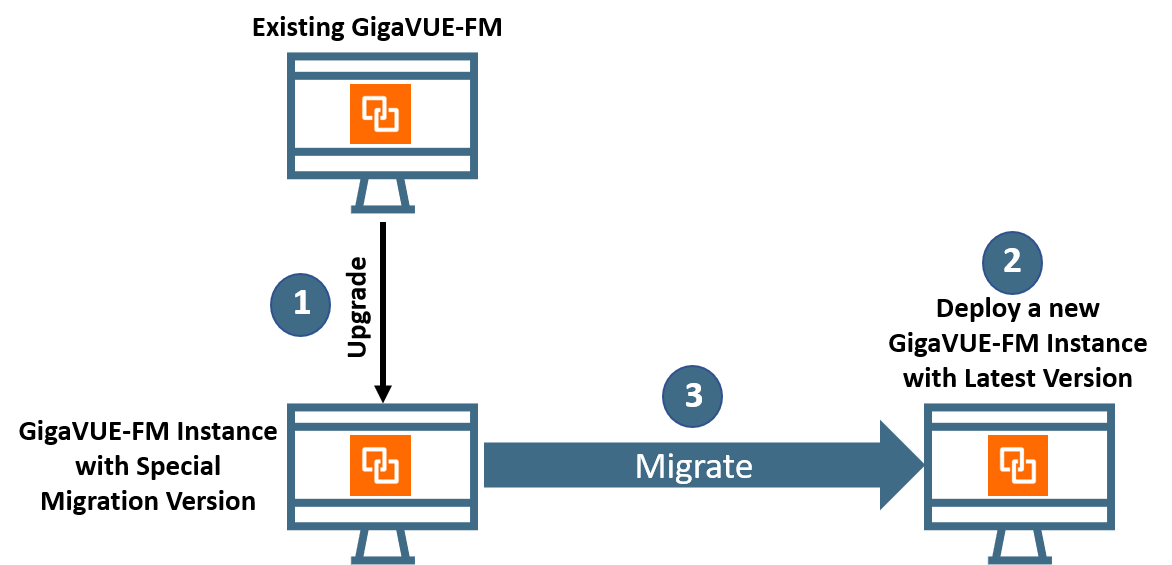
Before proceeding with the migration, ensure that you meet the recommended system requirements and prerequisites. Refer to VMware Migration—System Requirements and Prerequisites.
To migrate GigaVUE-FM on VMware ESXi:
| 1. | Log in to the special migration version of GigaVUE-FM. |
| 2. | On the right side of the top navigation bar, click the Admin drop-down list, and then select Software Upgrade. The Software Upgrade Wizard appears. |

| 3. | Ensure that you meet all the prerequisites listed on the Requirements screen of the Wizard. |

| 4. | Click Next. The Set Up Connection screen of the Software Upgrade Wizard appears. |
| 5. | Enter the IP Address or Hostname of the latest version of GigaVUE-FM. |
| 6. | Enter the login credentials such as the Username and Password, and then click Connect. The connection is established between both the GigaVUE-FM instances. |
| 7. | Click Next. The Migration Data screen of the Software Upgrade Wizard appears. |
| 8. | Select the Data Files check box to migrate the statistics, events, audit logs, and syslogs. By default, all the configuration files will be migrated. |
| 9. | Enter the number of days for which you want the data to be migrated. The estimated time for migration appears in the Wizard. |
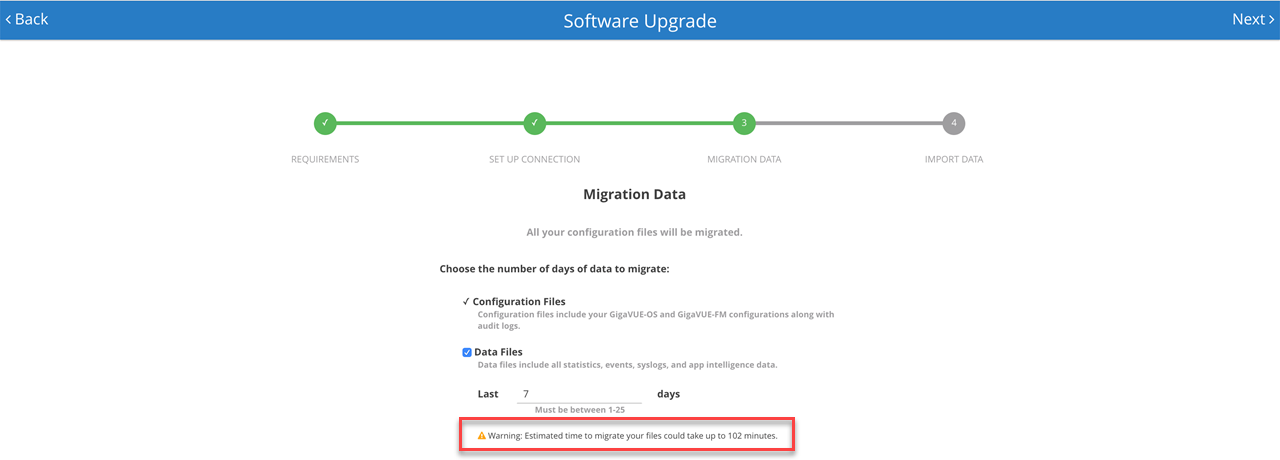
| Figure 1 | Estimated Migration Time |
| 10. | Click Next. The data migration process begins. All the files will be exported from the special migration version of GigaVUE-FM and then imported to the latest version of GigaVUE-FM. |
Note: The migration process will continue in the background even if you close the browser. You can login again to check the migration status.
| 11. | After the migration is complete, Click Finish. |
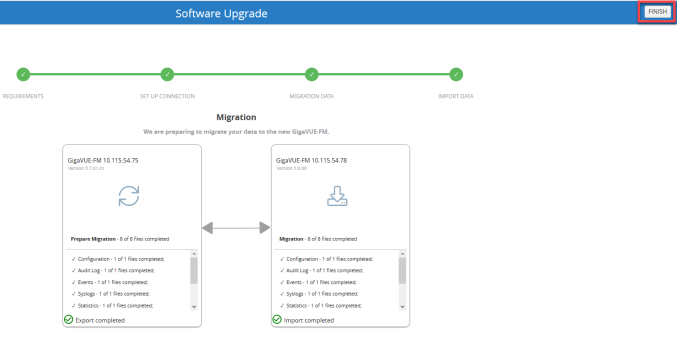
| Figure 2 | Migration Process Complete for VMware ESXi |
After the migration is successful, you can decommission the GigaVUE-FM instance with the special migration version.
GigaVUE-FM and VMware NSX-V communicate with each other using the GigaVUE-FM’s IP address, which acts as a service manager. When you migrate from the special migration version to the latest version of GigaVUE-FM, the IP address that is configured as the Service Manager in VMware NSX-V does not change. You must manually configure the IP address and SHA-1 Thumbprint of the latest version GigaVUE-FM.
Before you proceed with the configuration, ensure that you meet the following prerequisites:
| • | You have decommissioned the GigaVUE-FM instance with the special migration version. |
| • | You have made a note of the IP address and SHA-1 Thumbprint of the latest version of GigaVUE-FM instance. You can get the IP address and SHA-1 Thumbprint from the About GigaVUE-FM page. To access the About GigaVUE-FM page, click |
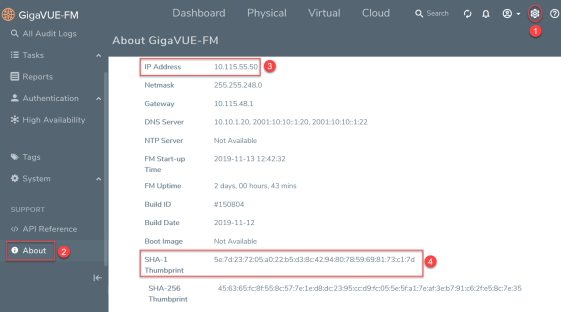
| Figure 3 | Accessing About GigaVUE-FM Page |
To configure GigaVUE-FM IP address as Service Manager for VMware NSX-V:
| 1. | Launch the VMware vSphere Web Client. |
| 2. | Go to Networking & Security > Service Definitions > Service Managers. |
| 3. | Select Gigamon Traffic Visibility Manager, and then click the Edit Service Manager icon. The Edit Service Manager page appears. |
| 4. | In the Administration URL and the Base API URL fields, replace only the IP address with the IP address of the latest version of GigaVUE-FM. |
| 5. | In the Thumbprint field, enter the SHA-1 Thumbprint of the latest version of GigaVUE-FM. |
| 6. | Click OK. |
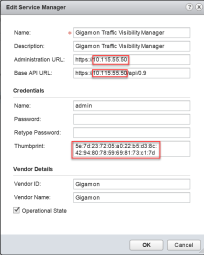
GigaVUE-FM Migration on Hardware Appliance
Use this option if you have a GigaVUE-FM Hardware Appliance running on GigaVUE-FM version 5.7 or lower that you want to migrate to the latest version of GigaVUE-FM.
Note: The migration process explained in this section is common for both GigaVUE-FM Hardware Appliance and GigaVUE-FM Hardware Appliance 2.0.
| • | Upgrade your GigaVUE-FM Hardware Appliance to the special migration version of GigaVUE-FM, which provides the tools to manage and perform the migration. |
Note: To obtain the required software images, register on the customer portal and download the software.
| • | In GigaVUE-FM Hardware Appliance 2.0 running on GigaVUE-FM version 5.7 or lower, if 1 Gigabit interface is used as management port, the eth2 interface will be configured for DHCP. However, when you migrate the GigaVUE-FM Hardware Appliance 2.0 to the latest GigaVUE-FM version, the interface names will swap from eth2 to eth0 for DHCP. |
| • | The GigaVUE-FM with special migration image is only to be used for migration to the latest version of GigaVUE-FM. It is not intended for managing production nodes. Upgrades from earlier GigaVUE-FM releases to the migration image must immediately be followed by an upgrade to the latest version of GigaVUE-FM within the same maintenance window to avoid any performance challenges. |
The following table provides the GigaVUE-FM Hardware Appliance specification:
|
Reference |
Gigamon SKU |
Dell Model |
iDRAC |
CPU |
RAM |
HDD/SSD |
NIC |
||||||||||||
|---|---|---|---|---|---|---|---|---|---|---|---|---|---|---|---|---|---|---|---|
|
GigaVUE-FM Hardware Appliance |
GFM-HW0-FM010 |
R430 |
iDRAC 8/7 and lower |
12 vCPU |
16 GB |
|
4x1 GB Ethernet |
||||||||||||
|
GigaVUE-FM Hardware Appliance 2.0 |
GFM-HW1-FM010 |
R440 |
iDRAC 9 and above |
32 vCPU |
128 GB |
|
|
Step 1: Backup your data and configuration files from your GigaVUE-FM instance to an archive server. For instructions on how to backup the data, refer to the “Backup Immediately” section in the GigaVUE-OS and GigaVUE-FM Administration Guide.
Step 2: Upgrade your existing GigaVUE-FM instance to the special migration version. For details about the supported special migration version and the upgrade path, refer to Supported GigaVUE-FM Migration and Upgrade Paths. For upgrade instructions, refer to Upgrade an Existing GigaVUE-FM Deployment.
Step 3: Log in to the special migration version of GigaVUE-FM and start the migration process.
Step 4: Install the GigaVUE-FM Hardware Appliance with the latest version of GigaVUE-FM using an ISO file. For installation instructions, refer to the Migrate GigaVUE-FM Hardware Appliance.
Note: To obtain the required software images, register on the customer portal and download the software.
Step 5: After the latest version of GigaVUE-FM is installed, the restoration process gets triggered automatically.
The following figure illustrates the migration process on the GigaVUE-FM Hardware Appliance.
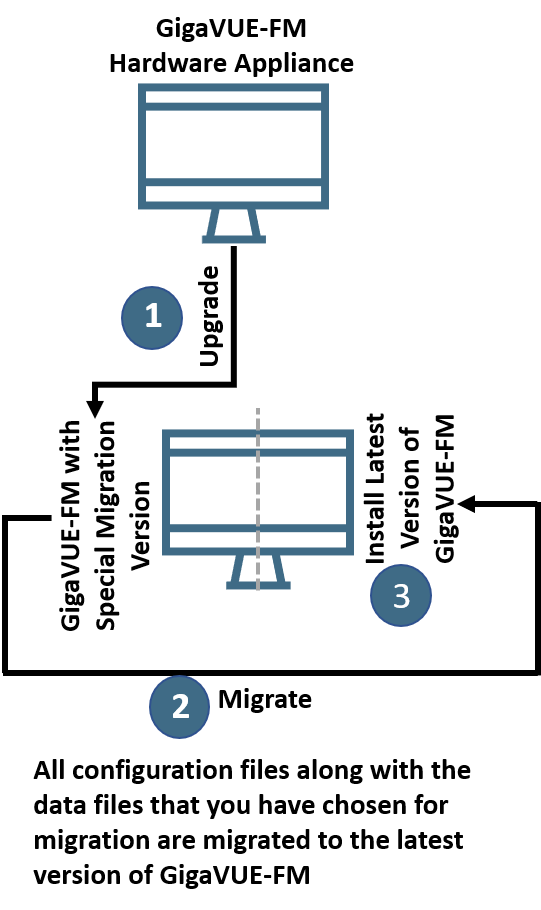
Before proceeding with the migration, keep in mind the rules and notes listed in GigaVUE-FM Hardware Appliance Migration—Rules and Notes
If you choose to set up the ISO image of the latest version of GigaVUE-FM using the automated process:
| • | Ensure that you have the login credentials of Integrated Dell Remote Access Controller (iDRAC) that is managing the GigaVUE-FM Hardware Appliance. |
| • | Download the ISO image of the latest version of GigaVUE-FM from the customer portal and save it to your Remote File Sharing (RFS) server. |
To migrate the GigaVUE-FM Hardware Appliance to the latest version of GigaVUE-FM:
| 1. | Log in to the GigaVUE-FM Hardware Appliance running on the special migration version of GigaVUE-FM. |
| 2. | On the right side of the top navigation bar, click the Admin drop-down list, and then select Software Upgrade. |
The Software Upgrade Wizard appears.

| 3. | In the Setup ISO Image screen of the Software Upgrade Wizard, choose one of the following methods to set up the ISO image of the latest version of GigaVUE-FM: |
| • | Manual—You must download the ISO image of GigaVUE-FM5.10.xx from the customer portal. Mount the ISO image to your Hardware Appliance. The Hardware Appliance reboots after the ISO image is loaded. For details, refer to Set Up the GigaVUE-FM ISO Image Manually. |
| • | Automatically—Set up the ISO image using an automated process. |
Complete the following steps if you choose to set up the ISO image automatically:
| a. | Under the iDRAC section, enter the IP Address, Username, and Password for iDRAC that is managing the GigaVUE-FM Hardware Appliance. |
| b. | Under the RFS section, enter the IP Address, Username, and Password of the Remote File Sharing server in which you have downloaded the ISO image of the latest version of GigaVUE-FM. |
| c. | In the ISO Image Path field, enter the absolute path of the ISO image. |
| d. | From the Protocol drop-down list, select NFS or CIFS. |
| e. | Click Connect. |
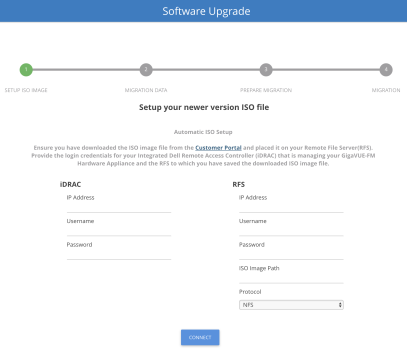
| 4. | In the Migration Data screen of the Software Upgrade Wizard, select the Data Files check box to migrate the statistics, events, audit logs, and syslogs. By default, all the configuration files will be migrated. |
| 5. | Enter the number of days for which you want the data to be migrated. By default, seven days of data will be migrated. |
| 6. | Click Next. The data migration process begins. All the files will be converted to the format of the latest version of GigaVUE-FM and will be restored on the Hardware Appliance. |
Open a new tab and then log in to the latest version of GigaVUE-FM to check if the migration process is completed.
Ensure that you change your password at your first login to GigaVUE-FM Shell. The password must be a minimum of 14 characters in length and must include at least:
| • | One numerical character |
| • | One upper case character |
| • | One lower case character |
| • | One special character |
After you change your password, you will be logged out of GigaVUE-FM Shell from the current session. You must log in again with your new password.
You can perform a manual installation of ISO image either from local file system or RFS server. Before proceeding with the ISO installation, it is recommended that you set up the boot sequence in the following order:
| 1. | Hard disk |
| 2. | Physical DVD |
| 3. | Virtual DVD |
Refer to the following table for details about how to install an ISO image using iDRAC:
|
Task |
Description |
Refer to: |
||||||||||||||||||
|---|---|---|---|---|---|---|---|---|---|---|---|---|---|---|---|---|---|---|---|---|
|
Set up the first boot device |
Whether you choose to install the ISO image from local file system or remote file sharing server, ensure that you set up the first boot device in iDRAC.
|
"First Boot Device" section in the Integrated Dell Remote Access Controller Online Help. Note: Press the F1 key in the iDRAC user interface to access the Integrated Dell Remote Access Controller Online Help. |
||||||||||||||||||
|
Install the ISO image from the local file system |
Before proceeding with the ISO installation, ensure that you have downloaded the latest version of GigaVUE-FM ISO image to your local file system. To obtain the required software images, register on the customer portal and download the software.
Wait for 30-45 minutes for the ISO image to install and the data to be migrated. Note: It may take 2 to 3 reboot cycles for the migration process to be completed. After the migration process is completed, you will see the GigaVUE-FM login prompt in which the hostname of the GigaVUE-FM appears. You must now disconnect the virtual media. |
|||||||||||||||||||
|
Install the ISO image from remote file sharing server |
Before proceeding with the ISO installation, ensure that you have downloaded the latest version of GigaVUE-FM ISO image to a RFS server. To obtain the required software images, register on the customer portal and download the software.
Note: The http and https options are available only for iDRAC 9 v3.00.00.00 and above.
Wait for 30-45 minutes for the ISO image to install and the data to be migrated. |
"Remote File Share" section in the Integrated Dell Remote Access Controller Online Help. Note: Press the F1 key in the iDRAC user interface to access the Integrated Dell Remote Access Controller Online Help. |
||||||||||||||||||
|
Install the ISO image from USB |
Note: This option is applicable only for GigaVUE-FM Hardware Appliance 2.0 managed by iDRAC 9 v3.00.00.00 and above. Before proceeding with the ISO installation, ensure that you have downloaded the latest version of GigaVUE-FM ISO image and copied it to a 8 GB USB using the To obtain the required software images, register on the customer portal and download the software. |
"Management USB Settings" section in the Integrated Dell Remote Access Controller Online Help. Note: Press the F1 key in the iDRAC user interface to access the Integrated Dell Remote Access Controller Online Help. |
GigaVUE-FM Migration on AWS
Use this option if you want to migrate your GigaVUE-FM instance running on the AWS platform.
Note: The migration process is applicable only if your current deployment has GigaVUE-FM 5.7. For deployments with GigaVUE-FM 5.6 or lower, you must deploy a fresh installation of the latest version of GigaVUE-FM and create the configurations again.
Refer to the following sections for details:
Following is an at-a-glance view of the tasks that you must perform to migrate to the latest version of GigaVUE-FM:
Step 1: Stop the existing version of the GigaVUE-FM instance. Refer to Stop GigaVUE FM Instance.
Step 2: Create a snapshot of the second disk (dev/sdb) of the FM instance. Ensure to make a note of the snapshot ID. Refer to Create Snapshot of the GigaVUE-FM Instance.
Step 3: Upgrade your GigaVUE-FM 5.7 instance to the special migration version of GigaVUE-FM. For details about the supported special migration version and the upgrade path, refer to Supported GigaVUE-FM Migration and Upgrade Paths. For upgrade instructions, refer to Upgrade GigaVUE-FM Instance. To get the software image, contact customer support.
Step 4: Launch the GigaVUE-FM instance with the special migration version. While launching the instance, enter the snapshot ID of the old version of the GigaVUE-FM instance (that you have made a note of in Step 2) in Add Storage > Add New Volume.
Step 5: Verify if the data from the previous GigaVUE-FM instance is restored in the new instance. Ensure that you set up the same password that you used to access the old GigaVUE-FM instance.
Step 6: Initiate the migration process in the GigaVUE-FM instance with special migration version. Refer to Migrate GigaVUE-FM on AWS.
Step 7: After the migration is complete, stop the GigaVUE-FM instance with special migration version. Refer to Stop GigaVUE FM Instance.
Step 8: Create a snapshot of the second disk (dev/sdb) of the GigaVUE-FM instance with special migration version. Ensure to make a note of the snapshot ID. Refer to Create Snapshot of the GigaVUE-FM Instance.
Step 9: Upgrade your GigaVUE-FM instance with special migration version to the latest version of GigaVUE-FM. Refer to Upgrade GigaVUE-FM Instance. You can get the software image from AWS Marketplace or Community AMIs.
Step 10: Launch the latest version of GigaVUE-FM. While launching the instance, enter the snapshot ID of the GigaVUE-FM instance with special migration version (that you have made a note of in Step 8) in Add Storage > Add New Volume.
Step 11: Wait for about 10 minutes for the restore process to get completed before you login to the latest version of GigaVUE-FM instance. Verify if the data from the GigaVUE-FM instance with special migration version is restored in the GigaVUE-FM instance with the latest version. Ensure that you use the same password that you used to access the old GigaVUE-FM instances.
Step 12: Terminate the old GigaVUE-FM and the GigaVUE-FM with the special migration version.
The following figure illustrates the GigaVUE-FM migration process on AWS.
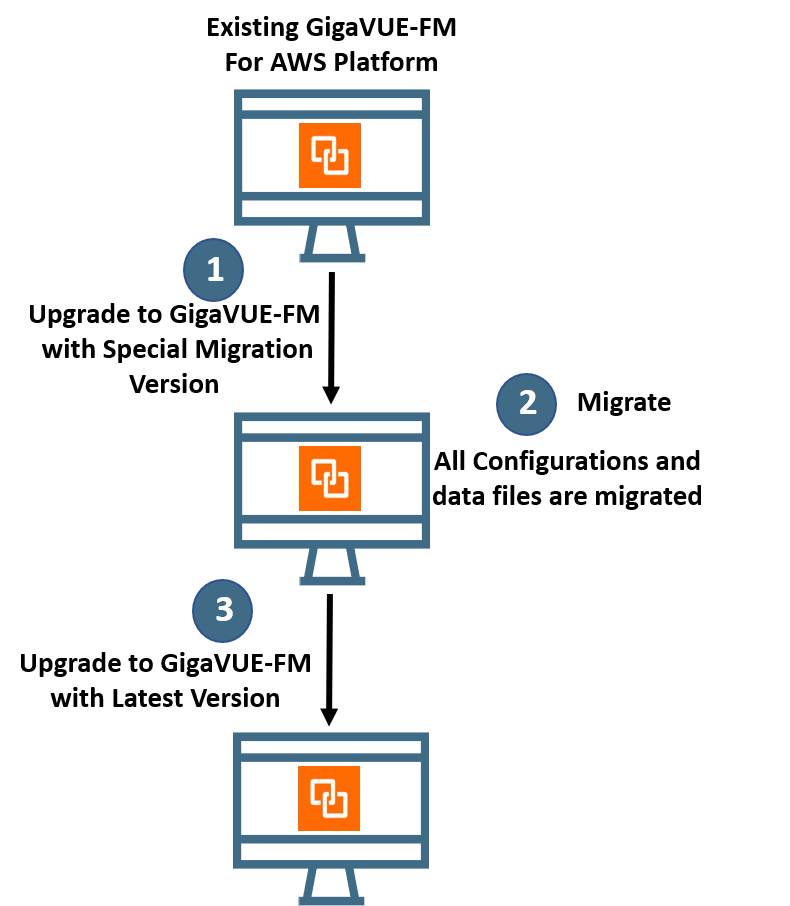
Before upgrading the GigaVUE-FM instance, the existing version of the GigaVUE-FM instance must be stopped.
Note: Do not terminate the GigaVUE-FM instance.
To stop the GigaVUE-FM instance:
| 1. | Login to the AWS account and select Services > EC2. |
| 2. | In the left navigation pane, select Instances. |

| 3. | In the search field, enter the name of the existing GigaVUE-FM instance and select the Instance ID. |
Note: If the instance ID is the password for logging in to the existing GigaVUE-FM, make note of this instance ID. This instance ID will be used as the password for logging in to the upgraded GigaVUE-FM as well. If the password is changed, use the changed password to login to the upgraded GigaVUE-FM.
| 4. | Go to Actions > Instance State > Stop. |
You must create a snapshot of the volume of the existing version (dev/sdb) of the GigaVUE-FM instance. Snapshots capture data that are written to your Amazon EBS volume at the time the snapshot is taken. This excludes any data that are cached by any applications or the operating system.
To create a snapshot:
| 1. | Select the GigaVUE-FM instance and click the Description tab. |
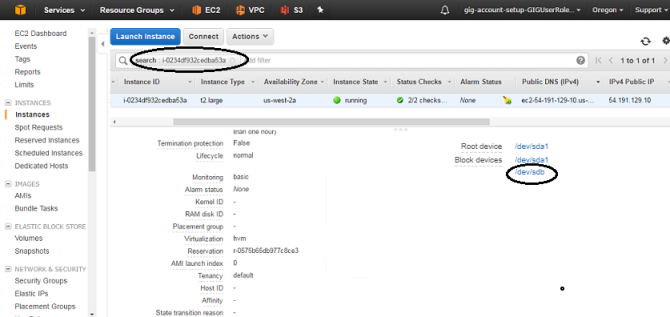
| 2. | Scroll down and locate Block Devices. |
| 3. | Click the /dev/sdb link. The Block Device dialog box is displayed with the volume ID link. |
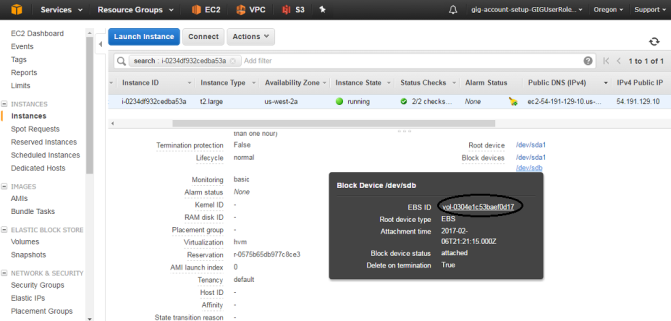
| 4. | In the Block Device dialog box, click the volume ID link. The Volumes page is displayed. |
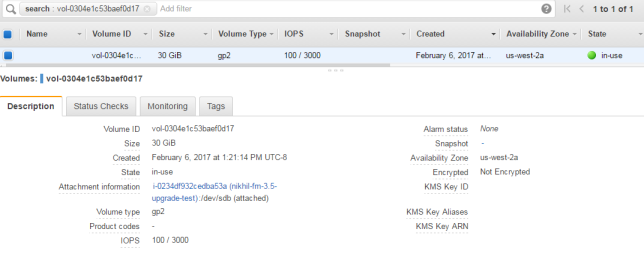
| 5. | Click Actions and select Create Snapshot. |
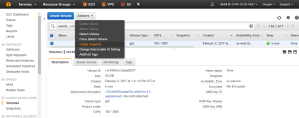
The Create Snapshot page appears.
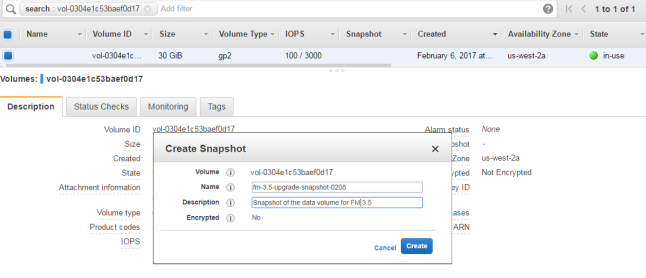
| 6. | Enter the description of the snapshot. |
| 7. | Click Add Tag to add the required key and value. |
| 8. | Click Create Snapshot. It will take several minutes for the snapshot to be created. |

Note: Make a note of the snapshot ID. This snapshot ID will be used to find the snapshot and add the volume while upgrading the GigaVUE-FM instance.
While upgrading the GigaVUE-FM instance, the Amazon EBS volume must be restored with the data from the snapshot that is created in Create Snapshot of the GigaVUE-FM Instance.
To upgrade the GigaVUE-FM instance:
| 1. | Select Services > EC2. |
| 2. | Click LaunchInstance and go to AWS Marketplace or Community AMIs. |
Note: The software image of the GigaVUE-FM with special migration version will not be available in the AWS Marketplace or Community AMIs. To get the software image, contact customer support.
| 3. | Search for Gigamon, locate the latest version of the GigaVUE-FM AMI, and click Select. |
| 4. | Choose the Instance Type. The recommended instance type is m4.xlarge. |
Note: Do not select the t2 instance types as they are not supported.
| 5. | Click Next:Configure Instance Details. |
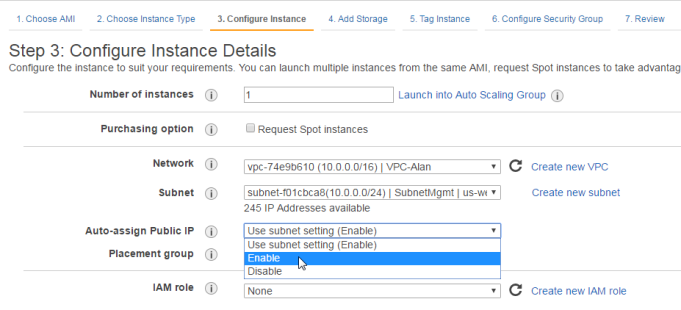
| 6. | Enter the following information. |
| • | Network— Select the VPC where you want to launch the AMI. |
| • | Subnet— Select the management subnet that the instance will use after launch. (Required) |
| • | Auto-assign Public IP— Select Enable. |
| • | IAM role—Select an existing IAM role to associate with the instance. Refer to the GigaVUE Cloud Suite for AWS Quick Start Guide. |
| 7. | Click Next: Add Storage and click Add New Volume. |

| 8. | Enter the following storage device settings: |
| • | Snapshot—Enter the name of the snapshot that is created in step 6 in the section Create Snapshot of the GigaVUE-FM Instance. |
| • | Size (GiB)— Enter the storage size of the volume. |
Note: When upgrading from your current version of GigaVUE-FM to the special migration version of GigaVUE-FM, ensure that the size of the volume is double the volume selected while launching the current version of the GigaVUE-FM instance.
However, when you upgrade from the special migration version to the latest version of GigaVUE-FM, ensure that the size of the volume is same as the volume selected while launching the special migration version.
| • | Volume Type— Select a volume type. The recommended volume is General Purpose SSD (GP2). |
| • | Delete on Termination—Select this check box to make sure the volumes are cleaned up when the GigaVUE-FM instance is removed. |
| 9. | Click Next: Tag Instance, and then add a key-value pair to identify the instance. |

| 10. | Click Next: Add Security Group. Click the Select an existing security group check box if the security group is already created. Otherwise, select the Create a new security group check box and click Add Rule. For more information on creating a security group, refer to the GigaVUE Cloud Suite for AWS Quick Start Guide. |
| 11. | Click Review and Launch. Review the instance launch details and click Launch. |
| 12. | Select the SSH key pair, check the acknowledgment check box, and click Launch Instances. |
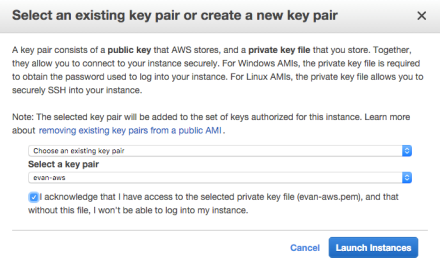
| 13. | It will take several minutes for the instance to initialize. After the initialization is completed, verify the instance through the Web interface as follows: |
| a. | Find the instance and expand the page in the Descriptions tab to view the instance information, if necessary. |
| b. | Copy the Public DNS value and paste the value into a new browser window or tab. |
| c. | Copy the Instance ID of the previous version of the GigaVUE-FM. If the password is changed, use the changed password to login to the upgraded GigaVUE-FM. |
Note: Do not have multiple versions of GigaVUE-FM instances monitoring the same AWS connection.
Before proceeding with the migration, ensure that you meet the following prerequisites:
| • | Ensure that you have upgraded your current GigaVUE-FM instance to the special migration version. For details about the supported special migration version and the upgrade path, refer to Supported GigaVUE-FM Migration and Upgrade Paths. |
Note: To obtain the required software images, contact customer support.
To migrate using this option:
| 1. | Log in to the special migration version of GigaVUE-FM. |
| 2. | On the right side of the top navigation bar, click the Admin drop-down list, and then select Software Upgrade. The Software Upgrade Wizard appears. |

| 3. | In the Migration Datascreen of the Wizard, select the Data Files check box to migrate the statistics, events, audit logs, and syslogs. By default, all the configuration files will be migrated. |
| 4. | Enter the number of days for which you want the data to be migrated. |
| 5. | Click Next. The Migration process begins. The Migration Data screen displays the estimated migration time for the specified number of days of data. All the selected data files along with the configuration files will be exported. This may take several minutes. |
| 6. | After the export is complete, you must upgrade the GigaVUE-FM instance to the latest version to complete the migration. |
For information about how to upgrade GigaVUE-FM in AWS, refer to Upgrade GigaVUE-FM Instance.

Frequently Asked Questions (FAQ)
| • | What versions of GigaVUE-FM are supported for migration? |
Migration is supported for 5.7 to 5.8, 5.9, and 5.10. Refer to the Supported GigaVUE-FM Migration and Upgrade Paths table for details.
| • | What if I am already running GigaVUE-FM 5.8? |
If the GigaVUE-FM version is already in 5.8 or above, then migration is not needed, you can just perform an upgrade.
| • | What platforms are supported for migration? |
Migration to the latest version of GigaVUE-FM is supported only on VMware ESXi, GigaVUE-FM Hardware Appliance, and AWS platforms.
| • | What if I am running GigaVUE-FM v5.7 or older on a platform that does not support migration? |
In this case, you will need to perform a fresh installation of GigaVUE-FM 5.8 or above. Beyond v5.8, migration is not needed, you can just perform an upgrade.



